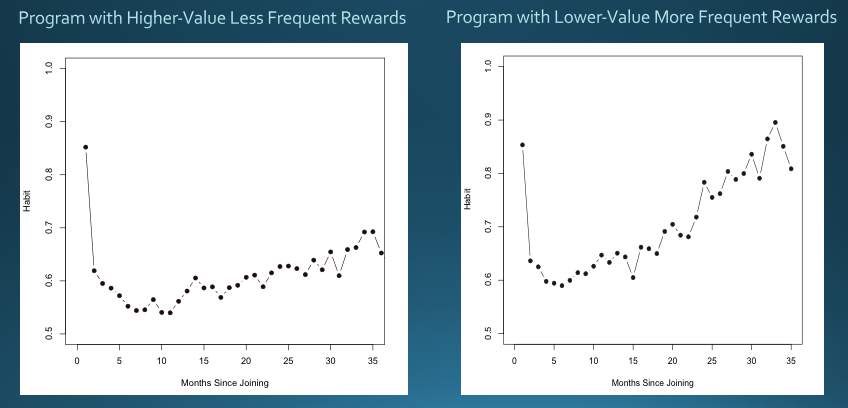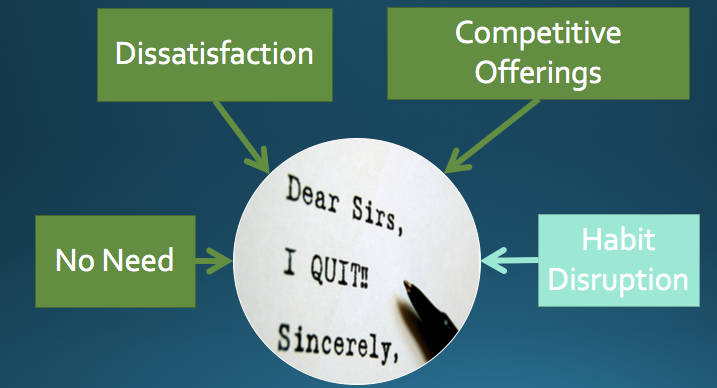Last week I wrote about how you should design your habit building strategy during the customer acquisition phase. In this Part 2 of the series, I would like to share some research insight on maintaining customer habit in order to reduce customer attrition. I don’t think I need to preach to you about the importance of retaining your customers. But what’s habit got to do with customer retention? Isn’t customer retention about how happy people are with your business? Well, habit has a surprisingly important role in this process.
Declining Habit as Early Warning Signs
There are many reasons why a customer may leave a business, such as no longer having the need for the product, experiencing a negative customer service episode, or seeing a more competitive offering somewhere else. Understandably, businesses devote a lot of energy to keeping their customers, mostly focusing on improving customer experience and delighting customers. These are certainly great things to do, but they are not for everyone and they should not be the only response. Why? Because the harsh reality is that consumers don’t care what they buy most of the time. They might have tried something incidentally, it was good enough, and they ended up sticking to it because it wasn’t important enough for them to try to find “the one”. Even for consumers who cared at the beginning, many eventually fall into a simple habit of buying and consuming a product without a second thought. These are situations where maintaining customer habit is important. In my research, I have seen declining habit as a good early predictor of customer attrition. Depending on the type of product, habit decline is observed from three months to as early as ten months prior to customer leaving the company or becoming inactive. So if you are tracking a customer’s habit and see such a decline, you will have precious time to do something before it is too late.
I should point out two things here. First, it’s not so much the level of habit but the decline in habit strength that spells trouble. So continuous monitoring of customer habit is important. Second, as I mentioned in Part 1, habit involves both frequency and stability. Sometimes these at-risk customers may be buying just as frequently. But if their pattern of purchase changes, habit may be broken. Say they used to often make a purchase at a certain time of day or at a certain location. But all of a sudden they are all over the place in terms of when and where they buy. That reduced stability in their behavior could mean that their habit is broken, and often it will be followed by decreased frequency, before attrition eventually happens. So be vigilant not only in terms of how much and how frequently your customers buy, but also pay attention to how they buy.
Reduce Instrumentality of Behavior
The scenarios mentioned above are less than ideal because you are patching something that may already be broken. The more proactive thing to do is to make sure that you build strong habit and maintain that strong habit among customers. To do so, it is important to understand the concept of “instrumentality”. It is the belief that what we do determines the outcome. When we learn that there is a high association between the effort we put in (e.g., purchases) and the outcome (e.g., free rewards), we are likely to consciously pursue that desirable outcome again in the future. This consciousness in pursuing a goal is actually not so good for habit. Habit is more likely to take shape when effort and outcome have less association with each other. So to encourage customer habit, you need to take clearly-defined goals out of the equation and add more random flavors into your customers’ experience. That is, you need to reduce the instrumentality of your customers’ behavior. How do you do that?
Implications for Reward Program Design
I will use reward programs as an example of how you can try to design your customer strategy with less instrumentality. From a habit perspective, reward programs can be a double-edged sword. On one hand, it has a built-in repetition component, as most programs require repeat purchases to receive a free reward. This repetition is good for habit development and maintenance. On the other hand, the reward component can make people more conscious of what it is they are after and, you know it, increases the instrumentality of behavior. So how do you design your program in such a way that it maximizes the upside and minimizes the downside?
The key lies in the design of the rewards. To make the reward goal less salient, it is best to use lower-value rewards that are handed out more frequently. For example, instead of earning a $30 reward certificate every quarter, it is much more habit-friendly to earn a $10 certificate every month. There are two reasons behind this. One is that high values are more enticing goals to pursue. By having ultra-nice rewards, you are essentially telling people to go after the reward as a big goal, something great for short-term motivation but not so good for long-term habit formation. The other reason is that frequent rewards desensitizes consumers to the rewards such that after a while they don’t pay so much attention to it any more, bringing more of the unconscious and automatic behavior back. The image below shows habit development in two real reward programs, and you can see that habit develops much faster and stronger in the low-value high-frequency reward program (right) than in the less frequent, higher value reward program (left).

I am not saying here that fancy high-value rewards do not have a place in reward programs. Quite the contrary, they can be great for a reward program. You just need to understand what it is that you want out of your program. If you are trying to woo your best customers and make them the happiest they can be, by all means let them work their way toward a free vacation and feel great afterwards. But if your goal is to develop and maintain habit among the average customer, you may want to dial down a notch and consider the more ordinary lower-valued rewards more frequently instead.
With this, I wrap up the second installment of the series. Please share your questions, thoughts, and comments. Next week, I will offer some insight on how to deal with habit when customer growth and expansion (e.g., cross-selling, up-selling, etc.) is the goal. To be notified about a new post on the blog, you can subscribe to Ping! via email by filling out the email subscription form in the side panel. Also if you find the information here helpful, please show some love and share the word!
